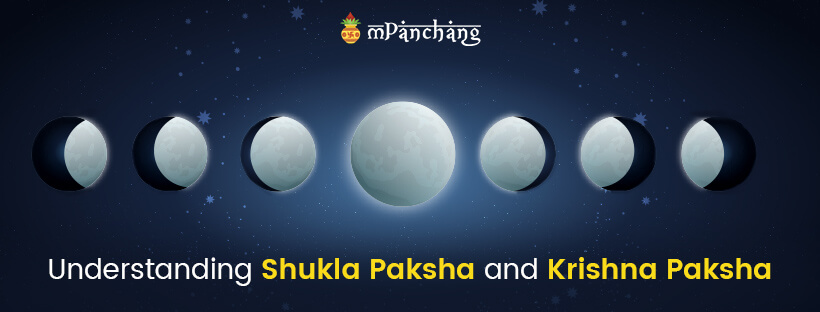Every time we plan for some big event or celebration in our family, we scroll through the calendar to look for auspicious dates and times and reach out to expert astrologers to narrow down a date that is a Shubh Muhurat. In this process, we do come across terms like Shukla Paksha and Krishna Paksha.
Understanding the heavenly events like Shukla Paksha Tithi and Krishna Paksha Tithi can help us learn various aspects of the celestial calendar and its impact on our lives. The difference between Shukla Paksha and Krishna Paksha is significant from a religious and astrological point of view. In this blog, we shall learn about Krishna Paksha and Shukla Paksha by diving into their meaning, significance, differences, and other related details.
What is the Meaning of Paksha?
As per the astrological calendar, every Lunar month is divided into two Pakshas. A Paksha is a lunar fortnight and lasts around 14 days. The literal meaning of the word Paksha in the Hindi language is 'the side.' In the context of astrological events, Paksha means a side of a month. Shukla and Krishna are the two sides or phases of the Moon.
As the Moon phase lasts 15 days, we usually have two Moon phases every month. The calculations indicate that the Moon traverses 12 degrees in a single day, completing its revolution around the Earth in thirty days.
What is Krishna Paksha Tithi?
Krishna Paksha begins from the full Moon (Poonam) and stays until the new Moon (Amavasya). During this period, the Moon starts to fade its form. The dates and timings falling under the waning Moon are known as Krishna Paksha Tithi. These Tithis are marked in the Hindu Panchang and are often associated with introspection, spiritual practices, and specific religious acts.
The term Krishna Paksha is related to Lord Krishna. As the skin complexion of Lord Krishna was Shyam (dull), the faded form of the Moon is termed Krishna Paksha.
READ: Shukla Paksha and Krishna Paksha in Hindi.
What is Shukla Paksha Tithi?
Shukla Paksha is period between the New Moon (Amavasya) and the Full Moon (Poornima). Shukla means bright in Sanskrit, and Shukla Paksha refers to the time of the bright or waxing Moon. As Shukla Paksha ends on the full moon day, we see a radiant and fully illuminating Moon disc in the sky.
Dates and timings that fall under the waxing Moon are known as Shukla Paksha Tithi. These Tithis, marked in the Hindu Panchang, are considered especially auspicious for religious ceremonies, new beginnings, and other significant events.
So, you can sum it up as the fortnight between the New Moon and Full Moon is Shukla Paksha (Waxing Moon), and the fortnight next to Shukla Paksha or the fortnight between the Full Moon and New Moon is called Krishna Paksha.
Difference Between Krishna Paksha And Shukla Paksha
The difference between Shukla Paksha and Krishna Paksha lies in the phases of the Moon and their symbolism. As mentioned above, the term Shukla means 'bright' in Sanskrit, representing the waxing phase of the Moon. This period starts from the day after Amavasya (New Moon) and ends on Purnima (Full Moon). During Shukla Paksha, the Moon advances in luminance gradually, symbolizing growth, positivity, and prosperity.
The term Krishna means 'dark' and refers to the waning phase of the Moon. This period begins the day after Purnima (Full Moon) and ends on Amavasya (New Moon). During Krishna Paksha, the Moon declines in brightness, conveying withdrawal, introspection, and endings. Thus, Shukla Paksha is associated with the increasing light of the Moon, while Krishna Paksha corresponds to the diminishing light of the Moon.
Also See: Ekadashi Dates Calendar
Which Paksha is Auspicious?
As per religious beliefs, Shukla Paksha (the waxing phase of the Moon) is usually auspicious, while Krishna Paksha (the waning phase of the Moon) is often less promising. This belief is rooted in the vitality and illumination of the Moon, with increasing brightness symbolizing growth and prosperity.
In Astrology, however, the auspiciousness of a Paksha is determined more precisely. The time from the tenth day of Shukla Paksha (Dashami) to the fifth day of Krishna Paksha (Panchami) is mainly favorable in astrology. This timeframe represents the phase when the Moon’s energy is at its peak or near maximum illumination.
The Moon's energy during this period is considered pivotal for determining Muhurats (auspicious timings) and other significant activities. This phase is said to bring a balance of illumination and energy, making it an ideal time for initiating new ventures, spiritual practices, or significant rituals.
Shukla Paksha And Krishna Paksha Calendar 2025
Let us determine the dates of Krishna Paksha 2025 and Shukla Paksha 2025 to learn the auspicious and inauspicious days of all the months:
|
Month |
Shukla Paksha Tithi 2025 |
Krishna Paksha Tithi 2025 |
|
January |
Jan 29, 6:06 pm - Jan 30, 4:11 pm |
Jan 14, 3:56 am - Jan 15, 3:21 am |
|
February |
Feb 28, 6:14 am - Mar 01, 3:16 am |
Feb 12, 7:23 pm - Feb 13, 8:22 pm |
|
March |
Mar 29, 4:27 pm - Mar 30, 12:49 pm |
Mar 14, 12:24 pm - Mar 15, 2:33 pm |
|
April |
Apr 28, 1:01 am - Apr 28, 9:11 pm |
Apr 13, 5:52 am - Apr 14, 8:25 am |
|
May |
May 27, 8:32 am - May 28, 5:02 am |
May 12, 10:25 pm - May 14, 12:36 am |
|
June |
Jun 25, 4:01 pm - Jun 26, 1:25 pm |
Jun 11, 1:13 pm - Jun 12, 2:28 pm |
|
July |
Jul 25, 12:41 am - Jul 25, 11:23 pm |
Jul 11, 2:06 am - Jul 12, 2:09 am |
|
August |
Aug 23, 11:36 am - Aug 24, 11:48 am |
Aug 09, 1:25 pm - Aug 10, 12:10 pm |
|
September |
Sep 22, 1:24 am - Sep 23, 2:56 am |
Sep 07, 11:38 pm - Sep 08, 9:12 pm (Pratipada Shraddha) |
|
October |
Oct 21, 5:55 pm - Oct 22, 8:17 pm |
Oct 07, 9:17 am - Oct 08, 5:53 am |
|
November |
Nov 20, 12:17 pm - Nov 21, 2:47 pm |
Nov 05, 6:49 pm - Nov 06, 2:55 pm |
|
December |
Dec 31, 3:56 am - Jan 01, 3:22 am Dec 20, 7:13 am - Dec 21, 9:11 am |
Dec 05, 4:44 am - Dec 06, 12:56 am |
Must See: Shadi Muhurat in 2025
Lets Sum Up!
The Hindu Panchang serves as a guide to gain insights into various celestial events and their influence on our lives. Following the guidelines can help us plan significant life events to achieve favorable outcomes. Now that you know Shukla Paksha is considered an astrologically auspicious period, you can align your important activities accordingly. Whether you are starting a new project, planning a housewarming ceremony, or any other significant event, consult an accurate Panchang to determine the most auspicious timings for success and prosperity!


 ज्योतिषी से चैट करें
ज्योतिषी से चैट करें










Leave a Comment